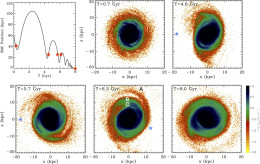Recent deep observations of the Large Magellanic Cloud (LMC), a satellite galaxy of the Milky Way, have revealed a faint arc of stars extending from its northern outskirts. Was this stream created by the gravitational pull of the Milky Way? Or could it have a more violent source?

The area surrounding the LMC. The stellar arc discovered with the Dark Energy Survey is shown in the region labeled A. The current study discovered additional asymmetric substructure in the region labeled C. [Besla et al. 2016]
Searching for Spiral Structure
When deep optical imaging by the Dark Energy Survey discovered this faint stream of stars extending eastward from the northern periphery of the LMC, scientists’ assumption was that this arm was created by the tidal pull of the Milky Way.
But a team of authors led by Gurtina Besla (University of Arizona) argue for an alternate theory: what if this stellar stream was instead caused by repeated interactions between the LMC and the Small Magellanic Cloud (SMC)?
One way to test these models is to look for a symmetrically corresponding arm in the south of the LMC extending west; such an arm would be expected if tidal forces from the Milky Way were acting globally on the LMC to create the northeast arm.
The Dark Energy Survey’s footprint doesn’t cover the southern regions of the LMC’s disk, but Besla and collaborators have an alternative: they performed their own wide-field survey using small robotic telescopes, which provide long exposures at low cost.
Modeling Past and Future Interactions

The simulated interaction history of the LMC and SMC in isolation (i.e., without the Milky Way). The top left panel shows the SMC–LMC separation as a function of time; the remaining panels show the system at different stages of the simulation. Only particles associated with the LMC are shown here; the SMC’s position is indicated by a blue star. [Besla et al. 2016]
To further test this model, Besla and collaborators ran a series of simulations of interactions between LMC and SMC, first in isolation and then with the added tidal forces from the Milky Way.
The simulations supported the conclusions drawn from the observations: while Milky Way tides may influence the final distribution of structures in the LMC’s outskirts, close interactions between the LMC and the SMC appear to be the primary cause responsible for the asymmetric spiral structure found.
As is shown in the authors’ simulations, the complete model of LMC/SMC interactions predicts that the two dwarfs will continue to interact until they eventually merge. Comparison of detailed simulations with future high-resolution observations of the LMC should help us further understand the interaction history of the LMC and SMC, thereby allowing us to better predict their eventual fate.
Bonus
Check out the gif below, cut from a video of the authors’ simulations. In these simulations, the SMC interacts with the LMC over the span of ~9 Gyr, passing through it several times before the LMC completely cannibalizes the SMC. You can visit the authors’ article to view the original video.
Citation
Gurtina Besla et al 2016 ApJ 825 20. doi:10.3847/0004-637X/825/1/20



6 Comments
Pingback: LMC SMC collisions
Pingback: LMC SMC collisions!
Pingback: Una historia de colisiones « SEDA / LIADA
Pingback: 충돌했음을 시사하는 대마젤란 성운과 소마젤란 성운 | zmon21님의 블로그
Pingback: Deep Magellanic Clouds Image Indicates Collisions - Gamification of Agile
Pingback: Imagens profundas das galáxias vizinhas Grande e Pequena Nuvens de Magalhães sugerem colisões » O Universo - Eternos Aprendizes